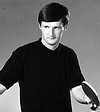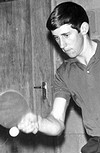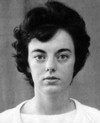Top People |
| Men's Singles Champion |
B A Foster (O) |
| Women's Singles Champion |
Mrs N Traill (NL) |
Ranking List |
Men
- B A Foster (O)
- M L Dunn (A)
- A R Tomlinson (A)
- G A J Frew (NL)
- M W Borlase (W)
- H J Waterhouse (W)
- G V Wilkinson (A)
- T J O'Carroll (NL)
- J Armstrong (C)
- G B Murphy (HV)
Women
- Mrs N Traill (NL)
- Mrs N J Houlihan (nee Attwood) (NL)
- Miss C E Johnson (H)
- Mrs J F Boswell (FR)
- Miss D L Wade (BP)
- Miss V M Rolston (H)
- Mrs M J Shadbolt (C)
- Mrs T May (C)
- Mrs J G Orr (ST)
- Miss Y M Fogarty (O)
Under 18 Boys
- G B Murphy (HV)
- H M Ridley (HV)
- P J MIlsom (W)
- P M Hall (ST)
- M G Eng (H)
- K Ward (C)
- G K Jackson (H)
- J Fisher (A)
- G J Williams (O)
- D G Couper (A)
Under 18 Girls
- Y M Fogarty (O)
- M J Fogarty (O)
- J A Cooper (MN)
- I J Crosby (FR)
- A D Johnson (BP)
- H M Nicholson (BP)
- L M Cornes (FR)
- S P Stevens (A)
- C G Stevens (A)
- M L Ward-Holmes (C)
|
| Executive Committee |
| J E Stewart (Chair), A G Davidson
(Dep Chair), W Mullins, A R Harding, W S R Jopson, R G Lea, R J
Menchi, D E Berry, Miss J E Brown, K C Wilkinson (Secretary), A R
Zillwood (Treasurer). |
|
First Ever Series Win Over Australia
4th August, 1966 is a date for NZ Table Tennis to cherish for ever. It was also a moment
of extreme tension and excitement. New Zealand had been in Australia since 25 July, played
exhibitions and tournaments and had beaten Victoria and Sydney in team contests. They had
also triumphed 3-2 in the first test in Adelaide. But the second test in Sydney on 4
August was their big chance, a chance to win their first ever test series against
Australia, and on Australia’s home turf to boot. Australia had made one change to its
team, bringing in previously injured Michael Wilcox to replace Murray
Thomson. Wilcox had been devastating against New Zealand when he toured this
country with Thomson in 1964. And Australia’s other player, retained for the Sydney
test, was Cliff McDonald – the reigning New Zealand Champion who had
beaten New Zealand’s Murray Dunn in the 1965 final.
 Dunn was unavailable for this tour although he had
participated in the trials. As it turned out, although he beat Alan Tomlinson
(pictured) twice, he was out-performed by him overall and also by Bryan Foster
and Garry Frew. Tomlinson and Foster were selected for the trip with Frew
named as reserve. As in recent years, a hand-picked group of younger players were
decisively out-performed in the trials by our established stars, all of whom have now been
at the top for a full decade. Dunn was unavailable for this tour although he had
participated in the trials. As it turned out, although he beat Alan Tomlinson
(pictured) twice, he was out-performed by him overall and also by Bryan Foster
and Garry Frew. Tomlinson and Foster were selected for the trip with Frew
named as reserve. As in recent years, a hand-picked group of younger players were
decisively out-performed in the trials by our established stars, all of whom have now been
at the top for a full decade.
The first test had begun with Tomlinson beating McDonald in a match with a most remarkable
score-line: 6-21, 21-18, 21-16, 6-21, 21-9. Foster then lost to Thomson in four games but
the Kiwis struck back with a decisive three-straight win in the doubles. McDonald had an
easy win over Foster leaving Tomlinson and Thomson to fight out the deciding match. New
Zealand hands flew into the air when Tomlinson, leading two games to one, clinched the
fourth 22-20.
In an earlier contest NZ had played Victoria, represented by Leigh Pascoe
and Graeme Stirling who would, three years later, tour New Zealand
together as an Australian team. Foster played well to beat both (his four game win over
Stirling was a thriller); the doubles was lost, leaving Tomlinson once again having to
play the deciding fifth match. He beat Pascoe 22-20, 21-16, 21-15.
The signs became ominous when both New Zealanders lost to Michael Wilcox
in the NZ/Sydney contest on 3 August, although NZ won overall, 3-2. Wilcox had been named
to replace Thomson for the second test the following night – the test to decide the
series. Came the night, Wilcox opened with a four game win over Foster (15, 18, -10, 19),
Tomlinson beat McDonald in five (18, 13, -14, -23, 15) and the New Zealanders won the
doubles (-15, 11, 22, -18, 18). With New Zealand needing just one of the last two singles
to win the series, Tomlinson faced his all-too-often nemesis Michael Wilcox. Tomlinson won
the first game 21-18, lost the second 13-21 and squeezed home in the third 22-20. Tension
was mounting. Wilcox won the fourth 21-16. Tomlinson won the fifth 21-18.
Foster’s five-game loss (21-17 in the fifth) to McDonald was of mere academic
interest. The series was won. History was made.
The tour was book-ended by the South Australia Open Championships on 27-29 July (the New
Zealand pair won the men’s doubles and Bryan Foster won the mixed
with an Australian partner); and a final team contest against New South Wales, in which
the New Zealanders suffered an anti-climactic 1-4 loss, winning only the doubles. The
opposition was McDonald (again) and former Australian Champion Geoff Jennings,
who had played in New Zealand for five years until last season but never won the national
title.
It was a superb tour for Tomlinson, who showed a cool demeanour and impeccable
sportsmanship throughout. He was unbeaten in the test matches in both singles and doubles,
often under extreme pressure and with his team seen by many, including NZ commentators, as
the underdog. The history-making series win was a fitting reward for the dedicated
Aucklander. He had travelled to previous Australian Championships and had paid his own way
to the 1963 World Championships in Prague, staying on to compete in major events in Great
Britain. The additional international exposure gained paid handsome dividends.
Foster also played well, saving his best for the crucial doubles matches. Both players
spent an intense week of training before leaving for Australia, with emphasis on doubles
play.
The tour took place shortly after the announcement that New Zealand was to send a team to
the 1967 World Championships (refer next article). The dramatic first-ever series win over
Australia was a welcome and well-timed boost to our national confidence ahead of the
ultimate challenge of a world event.
“Electrifying Announcement” - We’re Going to the World
Champs
“Electrifying Announcement at North Island Championships – New Zealand Side
For Sweden – Great Incentive For Table Tennis Players”
So trumpeted a six-column headline in Wellington’s Sports Post on Saturday, 16 July.
The lead-up to New Zealand’s involvement in the 1967 World Championships was fraught
with uncertainty. There was national celebration when the event was initially allocated to
Melbourne, Australia. What an opportunity! A New Zealand team could compete at minimal
cost and New Zealanders would flock to the event as spectators. Then came the bombshell.
The Australian Government refused visas for a team from North Vietnam, a country
Australian troops were engaged in warfare against, in support of the United States. The
ITTF responded by re-allocating the Championships to Stockholm, Sweden – a country
not involved in the Vietnam War and half a world away from New Zealand.
So with NZ’s participation now in doubt given the extra cost, the North Island
Championships announcement was indeed cause for “electrifying” excitement. New
Zealand had not officially selected a team for the World Championships since China in
1961, although a self-assembled women’s team which travelled to Prague in 1963 was
NZTTA approved. The announcement that a full team of at least three men and two women
would be selected for 1967 set the tongues of players, journalists and amateur selectors
buzzing. The team was to be announced at the 1966 NZ Championships.
No fewer than 18 names were mentioned in newspaper articles throughout the country in the
weeks prior to team selection. There was disagreement over whether developing players were
likely to be included at the expense of established players with better records. No trials
were to be held, leaving the North Island, South Island and NZ Championships the only
opportunities for selectors John Stewart, Alan McCallum and Eric
Smith to observe players in a highly competitive environment and ponder their
options.
In the event, they went for experience. They selected Murray Dunn, Bryan Foster,
Alan Tomlinson, Neti Traill and Cathy Johnson, with Johnson the
only new international. She had shown consistency and had earlier beaten Neti
Traill. Norma Houlihan (nee Attwood) was unavailable.
That could have been the end of the matter - but it got far more complicated. Over the
next three months four more players were added. Two had been named as non-travelling
reserves: Ann Theyers (nee Mutch) and  Harrison Waterhouse (pictured
left). Theyers was NZ Champion in 1964 and the left-handed Waterhouse, aged 20, had burst
to prominence with a win over Tomlinson in the quarter-finals of the just-completed NZ
Championships. The selectors had also recommended that two young players, Terry
O’Carroll (19) (pictured) Harrison Waterhouse (pictured
left). Theyers was NZ Champion in 1964 and the left-handed Waterhouse, aged 20, had burst
to prominence with a win over Tomlinson in the quarter-finals of the just-completed NZ
Championships. The selectors had also recommended that two young players, Terry
O’Carroll (19) (pictured)  and
Yvonne Fogarty (15), be invited to join the team provided they were able
to raise the finance (individually and through their Associations) to pay their own way.
Both took up the option, and, later still, the non-travelling reserves were invited to
join the team under the same conditions. Waterhouse accepted, Theyers declined and an
invitation was then made to 21 year old Dawn Wade (pictured), who
accepted. and
Yvonne Fogarty (15), be invited to join the team provided they were able
to raise the finance (individually and through their Associations) to pay their own way.
Both took up the option, and, later still, the non-travelling reserves were invited to
join the team under the same conditions. Waterhouse accepted, Theyers declined and an
invitation was then made to 21 year old Dawn Wade (pictured), who
accepted.
With the team (now numbering nine, plus manager Ken Wilkinson) finally
settled by the end of November, training, preparation, local fundraising and general
build-up could begin. Departure was set for 15 March, 1967, with three weeks of warm-up
competition in England and Scotland prior to the World Championships beginning in
Stockholm on 11 April.
|
Sponsored
Nationwide Junior Teams Tournament Launched
A new event was launched this year thanks to the generous sponsorship of soft-drink
manufacturer Schweppes (NZ) Ltd. The sponsorship enabled the final four teams in two
separate nationwide tournaments (one for boys, one for girls) to be transported to a
central location for the semi-finals and finals. A trophy for the winning teams and
individual prizes for team members were also covered by the sponsorship. The event was
keenly contested with Association teams playing off in groups and group winners facing
each other in quarter-finals.
Hutt Valley boys and Otago girls were the inaugural
winners.
Duplicate Barna Dunlop Cup Presented Enabling Separate Awards for Men and Women
The Barna Dunlop Cup has been presented annually at the New Zealand Championships since
1950, on the initiative of legendary world champion Viktor Barna, to
honour the team judged under a points system to excel in on-table behaviour,
sportsmanship, appearance, team spirit and punctuality. After negotiation between NZTTA
and Dunlop NZ Ltd, a duplicate cup was donated and from this year two Barna Dunlop Cups
are to be presented annually – for the winning men’s and women’s teams.
The winners of the inaugural twin cups were the men’s and women’s teams from the
same Association: South Canterbury.
South Islander Wins Men’s Singles at NZ Championships – First
Since 1948
Otago’s Bryan Foster triumphed at the NZ Championships to take the
trophy south for the first time since the patriarch of another famous Otago table tennis
family, Bill Fogarty, won it 18 years ago in 1948.
The southern women have done rather better with Joyce Williamson (twice),
June Magorian and Pat Purdon all winning since 1948,
Purdon the most recent in 1959.
It was an overdue reward for Foster, who was first selected to represent New Zealand in
1957 as a 17 year old and who has featured in multiple singles and doubles finals in both
NZ and North Island Championships. He has won the South Island singles six years in a row,
and also in 1957. His win in this year’s national final was decisive, three straight
over four-times champion Murray Dunn.
It was a high-pressure tournament with a New Zealand team to compete in the 1967 World
Championships due to be named on the final day and all the leading players vying for
selection.
University Teams Tour Australia
Seven university students represented New Zealand in a series of matches against
Australian university teams and also several state teams. The men’s team was PC
Salmon, HJ Waterhouse, BT Cross and BD Coley; the women’s ME
Bridson, S Craw and P Otway. The men won four team matches out of six, the women
lost only one. In the individual events Waterhouse won the men’s singles and Bridson
the women’s in the inter-varsity carnival in Sydney. They also won the mixed doubles
together.
The three week tour took place during the May university recess.
Round Robin Tournament Recorded for TV
On 17 September the Dunedin TV Channel (DNTV-2) hosted a round robin singles and doubles
tournament featuring Alan Tomlinson, Bryan Foster, Murray Dunn and
Harrison Waterhouse. Play was recorded for local screening and offered to the
other three NZ channels. DNTV-2 originally proposed the idea.
Poverty Bay Hosts First North Islands
First-time hosts Poverty Bay set a new standard in terms of information provided to
players, prizes, sponsorship, and the size of a special “Silver Jubilee”
programme (44 pages). They were determined not to allow the relative isolation of the
region and the inexperience of their officials to prevent the tournament from being the
best North Island Championships for many a year. In selecting a Tournament Manager they
were able to call on the experience of Frank Powell from neighbouring
Hawke’s Bay. A band of enthusiastic local administrators supported him.
The tournament hit national headlines when it was chosen as the forum for announcing New
Zealand’s decision to attend the 1967 World Championships in Sweden (refer earlier
article).

at the Championships
L/R: Frank O'Gorman, Les Elliott, Ivan Moffat
Inter-Association Team Contests Reduced to 11 Matches
After at least one previous unsuccessful attempt, a motion to reduce the number of matches
played in inter-association team contests at the NZ Championships from 12 to 11 was passed
at the 1965 Annual Meeting. The new format was introduced at this year’s
championships.
Waitemata Association Welcomed
This year the Waitemata Association was welcomed as a full member of NZTTA, after
previously functioning as a sub-association of Auckland.
National Raffle
NZTTA pocketed a profit of £1,489 from a nationwide raffle organized by Mr Norm
Ballinger. The money was earmarked for development and, with a world
championships coming up in 1967, to tours. Gross takings were £2,946 and £775 was
distributed to clubs and associations. 58,337 tickets were sold.
|